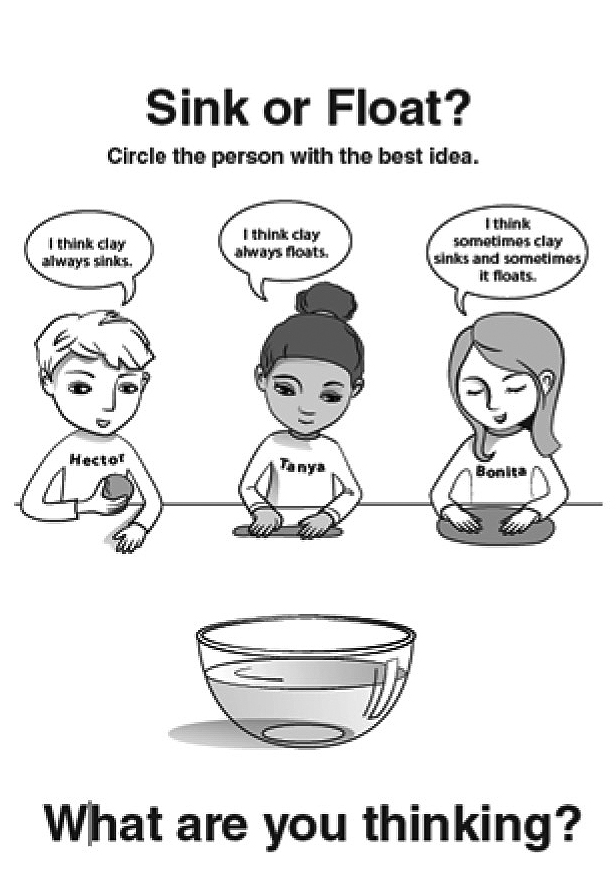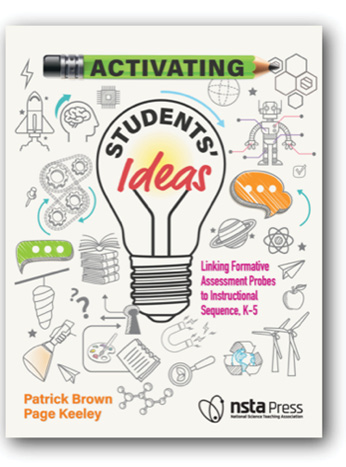formative assessment probes
Linking Formative Assessment Probes to the Explore-Before-Explain Instructional Sequence
Formative assessment probes are diagnostic questions purposefully designed to activate students’ thinking, reveal ideas students bring to their learning, and help teachers make responsive instructional decisions. They demonstrate how “starting with students’ incoming ideas lays the foundation for learning and sets up a need-to-know classroom learning environment” (Brown and Keeley 2023, p. xx). Starting with a formative assessment probe engages students’ thinking and is followed with firsthand experiences to “figure it out” through exploration, gathering evidence, making sense of the data by engaging in productive discourse, and reflecting on how ideas have changed or become more scientifically grounded. What does a lesson look like that uses this approach? In collaboration with Patrick Brown, a new NSTA Press book, Activating Students’ Ideas-Linking Formative Assessment Probes to Instructional Sequence K–5, merges the Uncovering Student Ideas probes with the Explore-Before-Explain instructional sequence. The eleven model lessons in this book help elementary teachers understand what teaching for conceptual understanding means and how to sequence instruction in which students engage in active meaning-making processes.
For example, sinking and floating is a common activity in K–2 classrooms. Typically, students test a variety of objects to determine which ones sink or float. They describe the properties of the objects, predict whether they sink or float, and then test their predictions. Often the activity ends after the students have made their observations and concluded which objects float or sink. Contrast this common activity with an “explore-before-explain” model lesson from Activating Students’ Ideas (Brown and Keeley 2023).
The lesson begins with the “Sink or Float?” probe (Figure 1) to elicit students’ initial ideas about floating and sinking (Keeley 2013). Using the representations of the shapes of clay shown on the probe, students considered whether the shape of clay determines if it sinks or floats. After sharing their initial ideas, students were given clay and created the three shapes shown on the probe—a ball, a rolled pencil shape, and a flat pancake shape. They used the same amount of clay each time and weighed the clay, finding that the clay weighs the same regardless of its shape. They made predictions about which shapes would float or sink, explaining their reasoning. Most students predicted the ball and rolled shape would sink and the flattened pancake shape would float.

Sink or Float? probe
The students tested their predictions for each shape, and to their surprise, contrary to their prediction, the flattened pancake sank. Next, students explored whether properties of other materials influence whether an object floats or sinks. They received three objects made of the same material, steel. The objects varied in size and weigh—a paperclip, a spoon, and a wrench. Students predicted the heavy ones (spoon and wrench) would sink but the paper clip, being light in weight, would float. Again, students are surprised!
The teacher then showed the students a picture of a large cargo ship with a steel hull and asked the students to consider how it could float since it is made from the same material they just tested. What could be different about the boat’s shape that allows it to float? Could they use the clay that sank to make a model of a boat that floats? They drew their models and then changed the shape of their clay to match their models. They discovered by turning up the sides of the flattened clay, they could make it float. The teacher then asked them to make their floating clay boats sink and observe whether it floated back up. The students observed that even though they had changed the shape so the boat would float, the same shape could also sink.
Following their explorations, the students were ready for the explanation phase. They shared what they had found out so far and described any patterns in their observations. They claimed, based on their evidence, that weight does not change when the shape of an object is altered, and weight alone does not determine whether an object floats or sinks. Finally, they connected what they learned about the shape of the floating clay boat to the shape of the floating steel cargo ship.
Next, they considered whether shape alone determines whether an object floats or sinks. They were puzzled as to why the same shape floated when the sides of the clay were turned up like a boat but the same shape could also be made to sink. They came up with the idea that there was air or “empty space” in the boat but if water got into the boat, it would make it heavier and sink. The other clay objects that sank did not hold air to make them float. There was a cause-and-effect relationship between the shape and the material. If the shape could also hold air, the object could be made to float.
A single property alone does not determine whether an object floats or sinks. Students then had an opportunity to revisit the probe and provide a scientific explanation supported with evidence from their observations. This conceptual understanding was not developed using concepts such as density, mass-volume relationship, and mixed density that are taught in middle school. Yet it provided a foundational experience for students to develop conceptual understanding of how sinking and floating depends on multiple observable properties.
With this new resource, Activating Students’ Ideas-Linking Formative Assessment Probes to Instructional Sequence K–5, you can see how lessons can be developed beginning with a formative assessment probe. An added feature are the illustrations showing how the lesson unfolds, examples of student work, and even links to videos. Overall, the model lessons in this new resource can help you make the important shift of starting with students’ ideas, providing experiences to explore those ideas to develop conceptual understanding, and then revisiting the probe to construct a scientific explanation.
Page Keeley (pagekeeley@gmail.com) is a science education consultant and the author of the Uncovering Student Ideas in Science series (http://uncoveringstudentideas.org).
Assessment Instructional Materials Phenomena Physical Science Teaching Strategies Elementary



